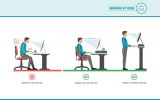
Consider Chair Alternatives
Every now and then, something we thought was permanent about the world will be changed suddenly by a new idea. In this case, standing desks have introduced the idea that offices don’t need office chairs. In fact, employees can sit on whatever makes them comfortable and productive. No one should stand 100% of the work day so transitions will happen and you can make them easier by helping your staff choose how they want to sit when they sit. Some standing desk users prefer a tall stool to rest on from time to time, others like a nice big exercise ball for their sitting time which is also great for desk workouts. Others will keep a desk chair or folding camp chair nearby for lumbar support when they rest.
Find a Posture Coach
One of the reasons some people have a terrible time adapting to standing desks is because they don’t know how to stand. Many people slouch, lock their knees, or simply never learned to line their spine and shoulders above the hips and stand in ‘parade rest’ for long periods of time. If you want standing desks to be a hit, make sure your team knows how to stand comfortably. A posture coach can be a training video, a demonstration, an employee assigned to help others, or a professional brought in from the outside.
Dynamic and Anti-Fatigue Standing
Finally, even with good posture no one stands in the same position for hours comfortably. Standing desk professionals have begun to explore interesting alternatives like a wobble board, foam tubes, step stools, and mini-elliptical machines for enjoyable standing that doesn’t leave you stiff. Of course, no matter how you mix it up, fatigue mats are an undeniable necessity as they turn the hard, unyielding floor into a conforming, supportive surface for your feet.
Whether your team is three people or fifty, introducing standing desks is a great way to promote employee health and break up the monotony of everyone sitting quietly without activity or movement for many hours at a stretch. Just make sure when updating the office to standing desks that you do so in a way that is workable and comfortable for everyone.
